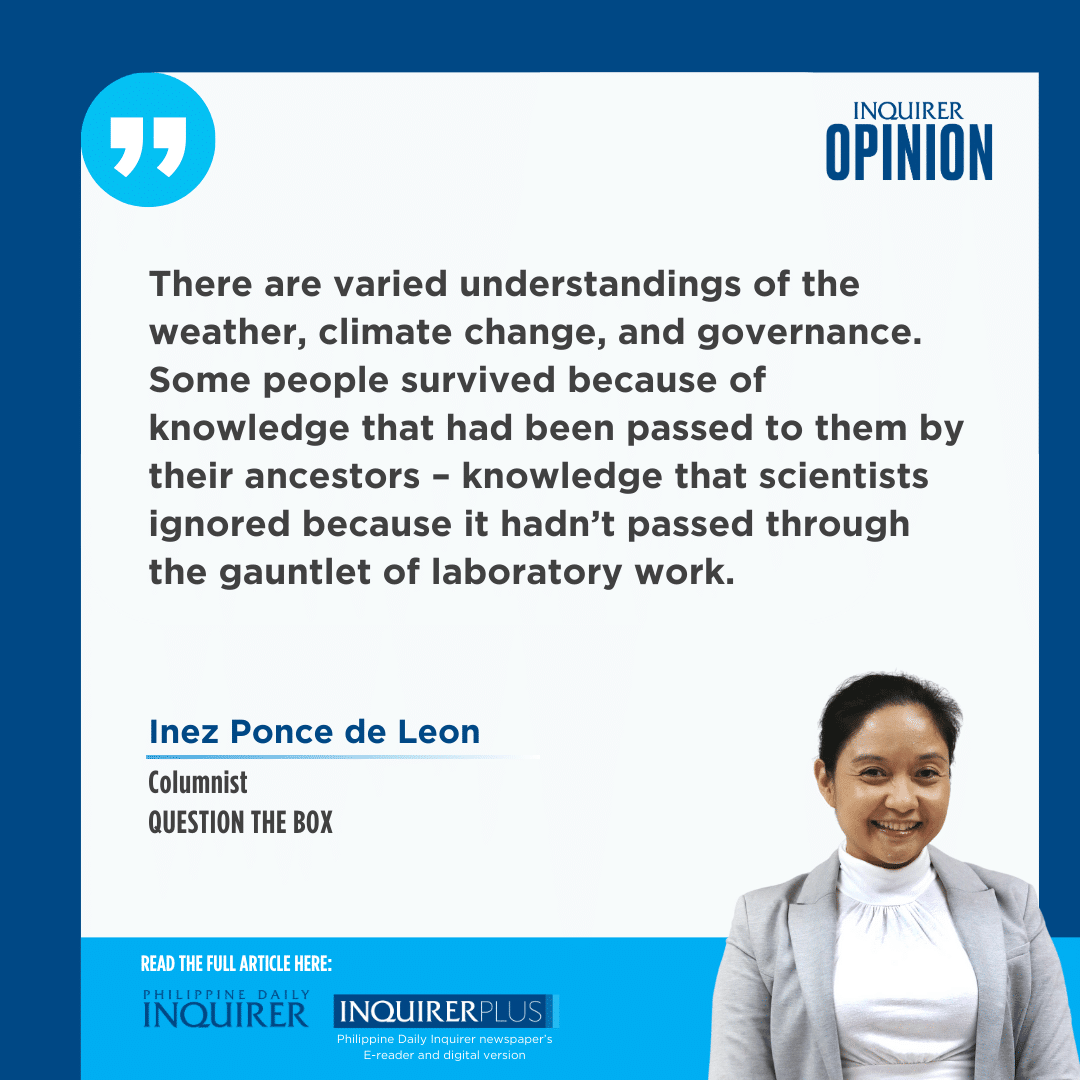
Last week, I had a feast with my field of study. It all started with a Zoom interview for TV Patrol, where I was asked to talk about making storm warnings more effective. I used my research to talk about how we need to study people and their concerns, and how warnings should be contextualized to these findings—how warnings need to be prescriptive rather than descriptive.
That is: in an emergency, people need specific instructions unique to their contexts, rather than descriptions of a future situation from which they have to intuit action. That advice became the center of my contribution to the news segment. On Wednesday, I spoke to a group of scientists at University of the Philippines (UP) Diliman, where I talked about going beyond pushing facts and disseminating information.
Scientists often insist on dissemination because they have been socialized into a world of measurable patterns, which can be used to predict and control future situations, and which they then use as their facts to disseminate. This approach, however, is replete with assumptions that I, as a scientist, had to let go. I had to accept that the world isn’t a giant lecture room, and people aren’t going to change their minds based on knowledge alone.
I had to study people first and be genuinely interested in their concerns. I surfaced these assumptions in the talk that day, so that the participants could see that science communication can include empowering specific groups to harness their own knowledge, so that they define and solve problems on their own. It can also include bringing different groups together into discussions so that their disparate knowledge and experiences can help them come to a common understanding of a problem and craft a solution.
These approaches arise from different, mutually exclusive paradigms, and it is their philosophy that forms the base of science communication as both research and practice. I was heartened to hear the audience’s comments and questions. Many of them realized where their beliefs were coming from.
One person even asked how they could start collaborating with researchers from other fields. They wanted to, but didn’t know how to start. On Saturday, I sat for a Teleradyo interview, this time with meteorologists Benison Estareja, BA Racoma, and Ariel Rojas.
They were all at the radio-TV studio while I spoke through Zoom, they who were the science communication practitioners with varying engagements with the public, me the science communication scholar with her research. I had actually dreaded the interview. It’s been over 20 years since I started working in the field.
I began as a practitioner in 2001 while finishing my masters. I thought my entire life would be spent doing genetics research, with a science communication side hustle. I loved the challenge of science and risk communication, however, and I pursued my Ph.
D. at Purdue in 2007. I thought it would be easy.
Within minutes of my first class, I was humbled by the depths of my ignorance of the social sciences. I became a true scientist then: the one who reveled in knowing nothing and learning new things, loved to ask questions and seek answers, carried out systematic research. When I returned in 2011, I advocated for more research into specific publics, making no assumptions about knowledge or its supposed links to action.
I had so few like-minded colleagues willing to ask the tough questions to embark on new research. I encountered pushback for years, from scientists who looked down on communication and thought my research frivolous, from auditors who insisted that I simply make communication materials even when my data told a different story. The story is this: people are different across the archipelago.
There are varied understandings of the weather, climate change, and governance. Some people survived because of knowledge that had been passed to them by their ancestors—knowledge that scientists ignored because it hadn’t passed through the gauntlet of laboratory work. Last week, I dreaded hearing the same litany of “Let’s just make the facts more attractive.
” At the radio interview, and with an idea prompted by the UP Diliman talk, I proposed that scientists need to be trained to collaborate with communication specialists. There is no monopoly on valid knowledge. Communication needs research to examine the interplay of people, culture, context, and circumstances.
I thought I would be shot down. Instead, we had a discussion, and we came to a consensus. We dreamed of local governments that would hire their own meteorologists working alongside communication experts, to ensure that a message could be contextualized to a specific public, for the specific ways they could expect to be affected by a storm.
It would be costly and difficult, but for a diverse country, it would be worth it. BA added: stories before facts. Change at last, in these last few days, after years of uphill battles.
We’re learning. The flock is growing. I’m just so happy to be a part of this kind of conversation.
————— Subscribe to our daily newsletter By providing an email address. I agree to the Terms of Use and acknowledge that I have read the Privacy Policy . [email protected].














